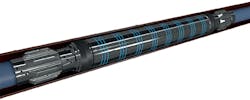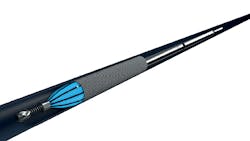Expandable, bismuth-based alloy ensures downhole sealing within minutes
Paul Carragher
BiSN
Cement has long been the established method for permanent plugging and abandonment (P&A) of offshore oil and gas wells. Although some have applied resins as an alternative, there have been relatively few new developments in downhole sealing technology, with the status quo remaining in cement’s favor.
TDAP device for completions, full main tool. (Images courtesy BISN)
Today, the integrity of downhole barrier materials is of increasing importance across the spectrum of activity, from completions to abandonment. Properly managed abandonments, in particular of subsea wells, can save the operator time and money, also ensuring that the environment is not negatively impacted.But there are significant limitations and difficulties associated with conventional abandonment methods.
BiSN has sought to address the concerns over downhole sealing technology by combining the unique properties of bismuth with the heat capacity of thermite. Bismuth has multiple commercial applications outside the oil and gas industry. For example, it is the main active ingredient in Pepto-Bismol and is also employed as an alternative to lead for solder and shotgun pellets. Use of bismuth for sealing in downhole environments is not a new concept – the Schlumberger brothers first explored the idea of using this alloy as sealant in the 1930s – but the process created by BiSN is unique.
The Wel-lok M2M MXD for well abandonments (maximum drift for thru-tubing applications).
The challenge in applying bismuth to create a seal has always been how best to deploy it downhole and exploit its capabilities to first melt, then solidify and expand, where the seal is required. Previous attempts all employed electrical heaters, which required large amounts of power (480V and 11A) to run for hours in order to melt a relatively small amount of bismuth alloy. The depth at which the tool could be run in the well was also limited due to voltage drops in the electric line. After melting, the electrical heaters were not able to keep the bismuth liquefied long enough for it to reach the sealing area and fill the void it was intended to seal.
BiSN’s approach harnesses the energy available from a thermite-powered chemical reaction heater to deliver an expandable, malleable alloy. The bismuth-based alloy is a type of metal that expands when it solidifies, just as water does when it turns to ice, and has a low viscosity (similar to water), and high density (10 times that of water) – a combination needed for an effective sealant.
The thermite serves to melt the heavy liquid alloy, which then flows, fills and moulds into downhole leak paths with gravity, eliminating the need to pump it into place. It can flow through the smallest gaps, including sand screens and corrosion pits, pushing wellbore fluids out of its path as it goes. The bismuth then expands by around 3%, forming a gas-tight seal on solidification.
Compared with electrical heat-based techniques, the thermite-powered Wel-lok M2M technology speeds up the heating time required to deliver an effective seal from hours to minutes, by quickly generating over 10,000KJ. As this heat is produced through a chemical reaction, it is non-explosive and does not require any permits or special handling. And by removing the need for specialist wireline equipment, the technology also reduces downtime and costs.
Over the past five years BiSN has been working to improve the control of this chemical reaction so that its use can be safely tailored to varying well needs. The company has developed a suite of tools designed around this technology, for use on a wide range of applications. These are run in-hole on an electric line requiring only 240 V and 60 milliamps for 15 seconds. The seal created upon alloy solidification is V0 gas-tight (the highest ISO standard for pressure rating), and in accordance with ISO 14310, and its integrity cannot be compromised, as the bismuth is non-corrosive and is unaffected by H2S (hydrogen sulfide), CO2 (carbon-dioxide) or acid washes.
The technology was first deployed in 12 test wells onshore in Oklahoma, followed by runs in two wells in Alaska, with subsequent deployments offshore in the Gulf of Mexico and West Africa.
Last year, BiSN conducted its first North Sea deployments, and last December The Oil and Gas Technology Centre in Aberdeen decided to provide financial support for qualification of the technology as a permanent P&A barrier. The Centre thus joins BP, Schlumberger, GE, and ConocoPhillips as investors in the company. Early this year there was a first Canadian deployment of Wel-Lok M2M technology, and there are plans to extend applications to wells in Azerbaijan, Equatorial Guinea, and Algeria.


